The Nervous System
Neuron Structure
The structure of glial cells and neurons
Glial Cells
Glial cells provide scaffolding on which the nervous system is built that helps neurons line up for neuronal communication. Glial cells also provide insulation to neurons to transport waste products out and nutrients in, while mediating immune response.
Neurons
Neurons are interconnected information processors that are essential for all tasks of the nervous system.
All neurons are polarized and are specialized to receive and send information.
1:1 ratio of glial cells to neurons
Neuron Structure
Outer Surface
A neuron’s outermost surface is made up of a semipermeable membrane. This semipermeable membrane allows smaller molecules and molecules without an electrical charge to pass through it and stops large and/or charged particles from passing through it.
Soma
The soma is the cell body where the neuron nucleus is located. The cell body contains the nucleus and most of the major organelles.
Dendrites
Dendrites are branching extensions from the soma. They serve as input sites where signals for shorter processes are received from other neurons. Neurons can have many tapered dendrites.
Axon
Axons range from a fraction of an inch to several feet. They extend like a branch away from the soma and serve as transportation for signals to another cell.
Myelin Sheath
Certain glia cells may form a fatty substance called myelin sheath. Myelin sheath coats an axon, acting as an insulator. This added insulation increases the speed a signal can travel. The loss of insulation can be detrimental to the function of a cell. Myelin sheath is not continuous down the axon. The myelin sheath contains gaps known as Nodes of Ranvier. Voltage-gated channels are found here.
Synapse
Synapses are the principal mode of communication between neurons and from neurons to other tissues. Neurons communicate with each other by using synaptic transmision and synaptic clefts. A synaptic cleft is a small space between two neurons where neurotransmitters are released.
Neurotransmitters
Neurotransmitters are the chemical messengers of the nervous system.
Receptors
Receptors are proteins on the cell surface where neurotransmitters attach. They vary in shape and are specific to one kind of neurotransmitter.
Gray & White Matter
The brain contains both gray and white matter. Gray matter is fresh brain tissue that is rich in neurons, synapses, and glia. White matter is the areas of the brain that contain mostly axons and glia. Signals are processed within the gray matter by groups of neurons that have similar functions, appearances, and in-/out- puts. White matter, rich in axons and their myelin sheaths, has an ivory or white color.
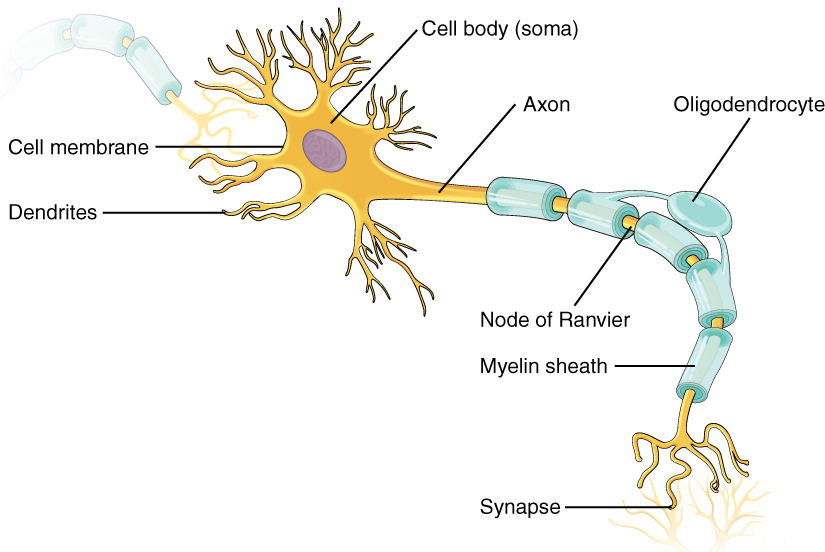
Neuron Structure
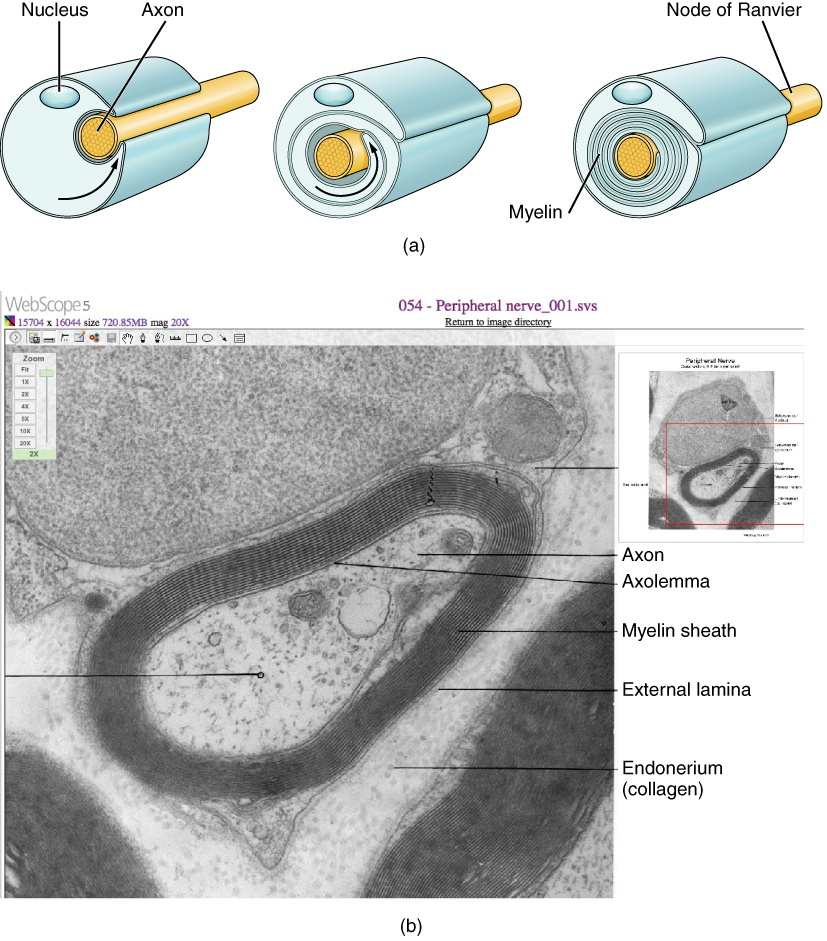
Myelin Sheath
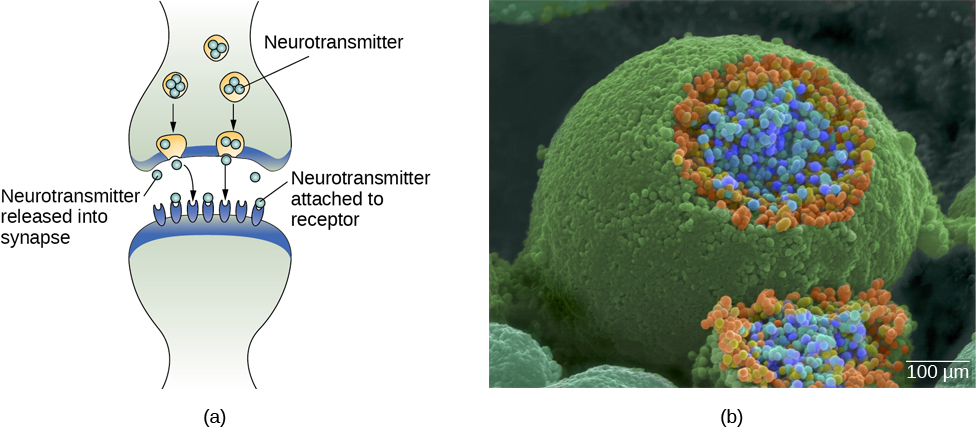
Neuronal Transmission
Response of the Nervous System
Somatic v. Autonomic
Somatic Nervous System
The somatic nervous system (SNS) is responsible for the conscious perception and voluntary responses of the body. This includes the contraction of skeletal muscles, and reflexes.
Autonomic Nervous System
The autonomic nervous system (ANS) is responsible for the involuntary control of the body, usually for internal regulation. Sensory input for autonomic functions can be both external and internal. The autonomic nervous system regulates the organ systems of the the body.
Sympathetic Nervous System
The sympathetic system is based on the adrenergic system. It is associated with the fight-or-flight response.
Parasympathetic Nervous System
The parasympathetic nervous system relates to the rest and digestion division of the body.
Neuronal Communication
How neurons communicate
Internal
Starting at the soma, signals are transmitted electrically across the soma and down the axon. The axon ends with multiple terminal buttons which contain synaptic vesicles that home neurotransmitters. The neuronal signal moves rapidly down the axon to the terminal buttons, where synaptic vesicles release neurotransmitters into the synaptic cleft. Once neurotransmitters are released, they travel across the synaptic cleft and bind with corresponding receptors on the dendrites of an adjacent neuron.
The neurotransmitter and the receptor have a lock-and-key relationship. This means certain transmitters fit certain receptors.
External
In the neuronal membrane, the neuron exists in a fluid environment, known as extracellular fluid. The neuronal membrane keeps the fluid inside of the cell, intracellular fluid, and the surrounding fluid, the extracellular fluid, separate. The electric signal depends on these fluids being separate and different. This difference in electrical charge causes membrane potential. The potential energy for the signal.
The electrical charge of the fluids is caused by the charged molecules, or ions, dissolved within the fluid. The semi-permeable membrane restricts the movement of these ions.
Between signals, the neuron is held at its resting potential. This signifies that the neuron is always ready. Ions are constantly ready to rush across the membrane when the neuron goes active and the membrane opens.
Ions in high concentration move to low concentration areas. For example, ions that are positive move to areas of negative charge, and ions that are negative move to areas of positive charge. This process may be facilitated by energy. In order to push an ion against its gradient, or against its normal way of travel, an active transport pump may be used. Active transport requires energy to push the ions against their common path.
From its resting potential state, the neuron receives a signal, and its state changes abruptly. When a neuron receives signals at the dendrites– from neuron transmitters of an adjacent neuron binding to its receptors– small pores or gates open on the membrane, allowing ions to move into the cell. If there is an influx of positive ions, the positive charge of the ion increases. If there is an influx of negative ions, the negative charge of the ion increases. If the charge reaches a certain level, the neuron becomes active and action potential begins. Many additional pores open, causing a massive influx and a positive spike in membrane potential. This is the peak action potential. At this peak, the cell quickly begins repolarization, pushing positive ions out and negative ions in. The cell hyperpolarizes, becoming negative, before returning to the resting potential.
Once a signal is delivered, excess neurotransmitters in the synaptic cleft drift away, are broken down into fragments, or are reabsorbed in reuptake. Reuptake occurs when a neurotransmitter is pumped back into the neuron that released it to clear the synapse. Clearing the synapse provides an “on” and “off” state and regulates the production of neurotransmitters.
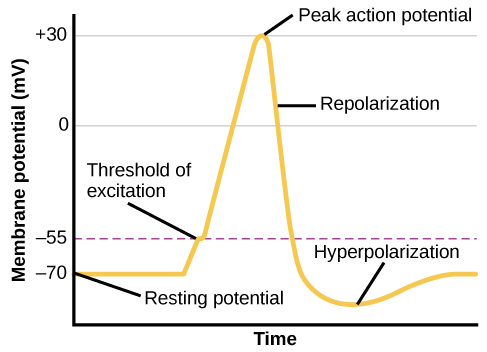
Action Potential
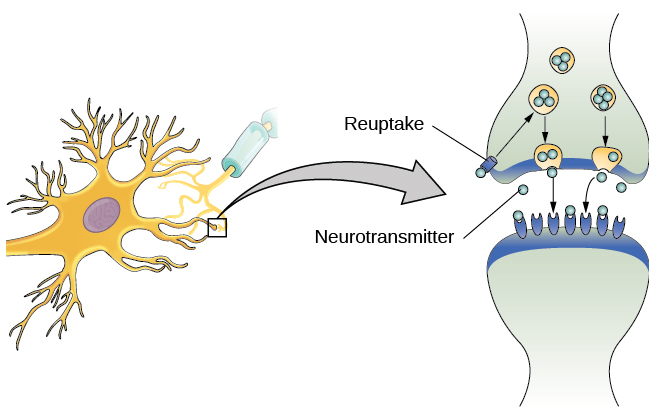
Neuronal Transmission- Reuptake
Sensing
Everything that is sensed is a physical event that needs to be converted into the currency of the nervous system. This process, transduction, is carried out by specialized nerve cells or sensory receptors.
Specialized receptors lead to the separation of sense.
Feeling
An emotion or feeling has an automatic, physiological manifestation such as facial expressions, changes in blood flow to the skin, and a queasy stomach.
Emotions are automatic, preconscious components that are accompanied by feelings, the conscious awareness of emotions.
Emotion and feeling motivate action. If something feels good, an individual is motivated to re-experience an occurrence. If something induces fear or distaste, an individual will avoid the occurrence.
Definitions
Extracellular Fluid
The fluid environment a cell is surrounded by; all fluid outside of the cell.
Intracellular Fluid
The internal fluid that the cell contains (i.e., cytoplasm).
Active Transport
The movement of ions through a cell membrane into a region of a higher concentration, aided by energy.
Resting Potential
The neuron membrane’s potential. At a constant state of readiness.
Action Potential
Occurs when an electrical signal moves down the axon. Action potential is an explosion of electrical activity that causes an impulse. At each point of interaction, ions that enter diffuse to the next section, raising the charge past the threshold and triggering a new influx of ions. Action potential is an all-or-none phenomenon. This means that the signal is either sufficient or insufficient to reach the threshold of excitation. Action potential is recreated at its full strength.
Membrane Potential
The difference in charge across a membrane.
Threshold of Excitation
The level at which the neuron becomes active and action potential begins.
Repolarization
The change in a cell’s membrane potential that returns it to its normal state.
Hyperpolarization
A change in a cell’s membrane potential that makes it more negative.
Reuptake
The action of the neurotransmitter being pumped back into the neuron that released it, in order to clear the synapse.
Transduction
The process of neuronal communication. It is the conversion of a sensory stimulus into electrical energy in the nervous system by a change in the membrane potential.
